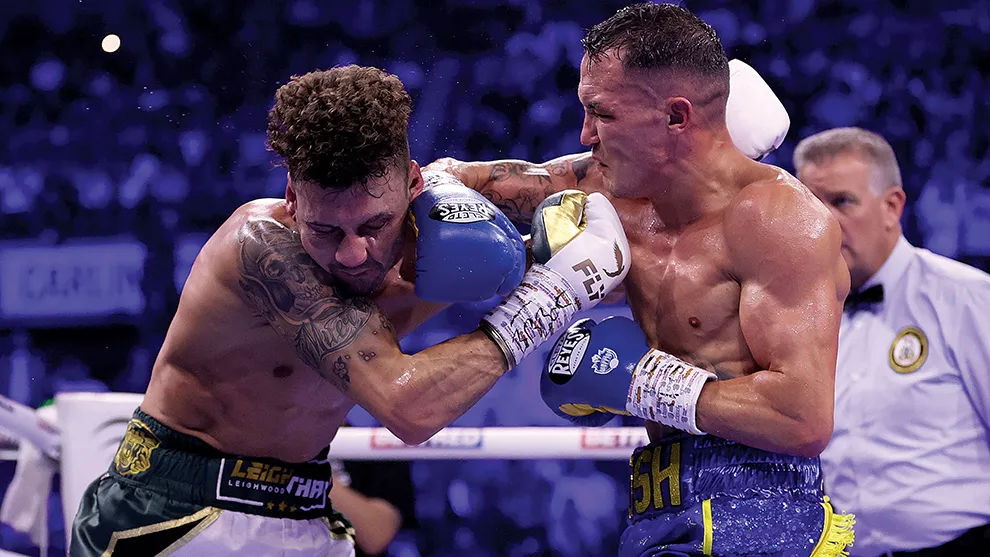The fight between Leigh Wood and Josh Warrington demonstrated the beauty of boxing when the matches are evenly matched. Unfortunately, this fundamental principle is often disregarded by promoters, broadcasters, managers, and even the boxers themselves.
Although the allure of a ‘world title,’ in this case the WBA featherweight strap, was undoubtedly a crucial factor in getting both Wood and Warrington to agree to the fight, it was far from the primary attraction for fans.
When we witness fights as thrilling as this one, it leaves us craving more. Whether a belt is on the line or not is largely irrelevant. In fact, ‘world titles’ no longer carry the prestige they once did, as has been extensively discussed in this publication before.
We, as fans, appreciate evenly matched fights, particularly when they involve fighters from the same country. This holds true regardless of the location. Therefore, domestic showdowns like Wood-Warrington should be happening with far greater frequency at all levels of the sport.
In Britain and Ireland alone, there are over 1,000 active fighters who can make that claim. Check any weight class on BoxRec and look at the top 20 fighters from Britain and Ireland in each division. The potential matchups are immense, with many being must-see encounters.
So, why don’t we see these fights happening more often? We are well aware of the reasons: rival promoters and networks struggle with collaboration, managers advise their boxers to avoid unnecessary risks to secure future financial returns, sanctioning fees are paid to compete for meaningless international belts against unknown opponents for the sake of a higher ‘world’ ranking, and as a result, the British title is not held in the high regard it deserves. Furthermore, glossy unbeaten records are treated as priceless commodities.
Already, some promoters may roll their eyes at this. “This is the boxing business,” they might say – and they would be correct. However, any business must adapt and closely listen to the desires of paying customers. The steady rise of influencer boxing can be seen as a consequence of not doing so. While it is undoubtedly diluting the sport, it also caters to the modern audience’s longing for competitive and familiar matchups. These events give the audience what they want: known fighters facing each other with uncertain outcomes. To this new breed of fight fan, that is far more appealing than watching a well-known ticket seller fight an unknown serial loser or a hot prospect face an unknown average opponent.
There are unwritten rules when it comes to developing fighters, and this is not a plea to completely abandon that process (I emphasize this because our previous mention of this subject drew significant criticism). When executed correctly, it is an art. An excellent example would be the development of Josh Taylor, who had to take risks to progress. However, not many fighters can reach Taylor’s level of skill and accomplishment. So, young boxers will face left-handed opponents, tall opponents, and short opponents, but almost always opponents who are considered to have no chance of defeating them. Then, once the education is complete or a high-ranking from a prestigious sanctioning body is secured, a superstar might emerge.
All of this is perfectly understandable. But are we missing an opportunity here? We have a sport that can provide more excitement than any other when done right. The more fights we stage that fulfill this desire for thrill, the more fans we will attract. Therefore, although I recognize that my perspective may be too logical, let’s focus on building the sport instead of building unbeaten records. Superstars will still emerge, that much is certain.
Breaking the cycle of prospects defeating no-hopers is difficult. Every promising boxer who turns professional undoubtedly needs some experience along the way. However, how many promising boxers with records like 10-0 are currently being protected from similarly skilled opponents? How often do we see two or more contenders in the same weight class refuse to fight each other? How frequently are entire fight cards composed of one-sided matchups featuring prospects or ticket sellers against opponents who only win fights every couple of years? Even on televised shows, it is not challenging to predict 80 to 90 percent of the outcomes. It is no longer just a sport; it is the boxing business.
Nevertheless, there is hope and signs of progress. National and Area titles are once again being regularly contested at smaller venues. We have witnessed tremendous battles on televised shows, and young prospects have been pitted against tough opponents (although even hardcore fans may struggle to recognize some of these opponents).
However, it feels like the steps we are currently taking are insufficient to prevent boxing – true boxing – from losing its way due to the challenge of breaking old habits. As much as we love this sport, do we genuinely enjoy sitting through four or five hours of undercard fights where all but one or two bouts are predictable mismatches? Can we justify paying £40 to watch one-sided four-rounders at smaller venues? Even if we find enjoyment in it, it is a tough sell for new fans.
Yet, we should celebrate fights like Wood-Warrington and cherish every reminder of how spectacular this sport can be. Wood, too, will undoubtedly look back on his career and be grateful that he did not allow any loss to hinder his progress or hesitate to face tough 50/50 opponents on his way up.
